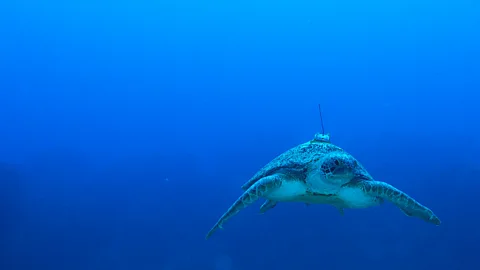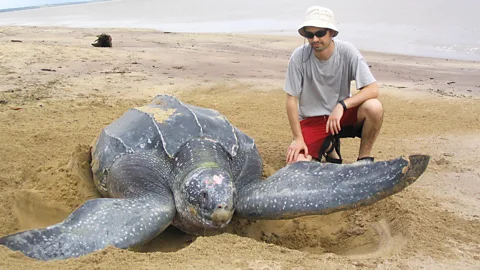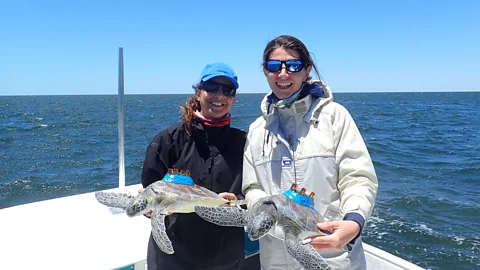From - BBC World News
By - Carla Rosch
Editted by - Amal Udawatta
 Thiege Rodrigues
Thiege RodriguesMarine turtles spend almost their entire lives at sea – but little is known about the paths they take. Now, satellites are helping scientists map their movements during the "lost years".
In early June 2024, Donna Shello, an adult female leatherback turtle, was hanging out on a sandy beach along the Caribbean coast of Panama. After laying about 80 eggs, and with a satellite transmitter attached to her back, she was ready to start competing in the Tour de Turtles, an intense oceanic "marathon" organised by the Sea Turtle Conservancy (STC), a US non-profit. This year, she is up against seven other leatherback females, and the winner will be the one who swims the longest distance.
"[Donna Shello] is at least 20 years old, but may be as old as 80 to 90," says Daniel Evans, a research biologist working at the STC. "There is currently no way to age a live sea turtle."
Although the "competition" only lasts three months, a full migration from nesting season to the next nesting season could take two years. From what they know so far, she has been laying between 70 and 90 eggs each time she nests, and could be nesting between four and seven times in a nesting season. "Based on three nesting seasons, she could have laid between 840 and 1,890 eggs since we first encountered her nesting in 2020," says Evans.
The STC has been tracking sea turtles for more than 20 years, monitoring their movements and migration patterns. Last year, a loggerhead turtle ventured further north than they had ever tracked before.
"Turtles are now going places that they didn't commonly go to," says Evans. "We are seeing them expand their range, exploring new areas that they either weren't able to before or didn't have a preference for."
 Tom Doyle
Tom DoyleMost species of sea turtles are temperature sensitive, so the areas of the ocean they can travel to are limited. "These [loggerhead] adults going that far north is an indicator that the temperature of those waters has increased and are now more comfortable for these turtles to survive in," Evans adds.
We depend on healthy seas for oxygen – experts estimate 50% of the world's oxygen comes from the ocean. Sea turtles are considered a keystone species, meaning they are crucial in maintaining an ecosystem's overall health. Green turtles, for instance, act as reef gardeners, grazing seagrass beds which helps maintain a healthy nutrient cycle; hawksbill turtles control populations of sponges, allowing space for corals to grow; meanwhile leatherbacks prey on jellyfish, keeping numbers in check.
Turtles also are also important biological transporters – carrying marine nutrients to land, leaving nutrients after nesting. They and their eggs are also important sources of food for other animals.
Their disappearance can create a cascade of negative impacts on marine and beach ecosystems. Currently, all sea turtle species are threatened with extinction. Six are classified as vulnerable, endangered or critically endangered by the International Union for Conservation of Nature (IUCN).
Sea turtles face multiple dangers across different life stages and habitats and, although they spend most of their lives in the water, there are still vast knowledge gaps about this part of their life. A 2021 study found only approximately 20% of research papers explored climate impacts on sea turtles in the ocean, and less than 5% were about turtles' distribution at sea.
 Florida State University
Florida State UniversityMariana Fuentes, marine conservation biologist and professor at Florida State University, has been studying sea turtles' behaviour in the ocean to identify some of those threats and is using scientific evidence to inform the design of marine protected areas (MPAs).
"I think satellite telemetry has been one of the tools that has helped most with conservation of sea turtles," Fuentes says.
Comments
Post a Comment